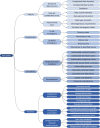Facilitating harmonized data quality assessments. A data quality framework for observational health research data collections with software implementations in R
- PMID: 33810787
- PMCID: PMC8019177
- DOI: 10.1186/s12874-021-01252-7
Facilitating harmonized data quality assessments. A data quality framework for observational health research data collections with software implementations in R
Abstract
Background: No standards exist for the handling and reporting of data quality in health research. This work introduces a data quality framework for observational health research data collections with supporting software implementations to facilitate harmonized data quality assessments.
Methods: Developments were guided by the evaluation of an existing data quality framework and literature reviews. Functions for the computation of data quality indicators were written in R. The concept and implementations are illustrated based on data from the population-based Study of Health in Pomerania (SHIP).
Results: The data quality framework comprises 34 data quality indicators. These target four aspects of data quality: compliance with pre-specified structural and technical requirements (integrity); presence of data values (completeness); inadmissible or uncertain data values and contradictions (consistency); unexpected distributions and associations (accuracy). R functions calculate data quality metrics based on the provided study data and metadata and R Markdown reports are generated. Guidance on the concept and tools is available through a dedicated website.
Conclusions: The presented data quality framework is the first of its kind for observational health research data collections that links a formal concept to implementations in R. The framework and tools facilitate harmonized data quality assessments in pursue of transparent and reproducible research. Application scenarios comprise data quality monitoring while a study is carried out as well as performing an initial data analysis before starting substantive scientific analyses but the developments are also of relevance beyond research.
Keywords: Data quality; Data quality indicators; Data quality monitoring; Initial data analysis; Observational health studies; R.
Conflict of interest statement
The authors declare that they have no competing interests.
Figures



References
-
- Fortier I, Burton PR, Robson PJ, Ferretti V, Little J, L'Heureux F, Deschenes M, Knoppers BM, Doiron D, Keers JC, Linksted P, Harris JR, Lachance G, Boileau C, Pedersen NL, Hamilton CM, Hveem K, Borugian MJ, Gallagher RP, McLaughlin J, Parker L, Potter JD, Gallacher J, Kaaks R, Liu B, Sprosen T, Vilain A, Atkinson SA, Rengifo A, Morton R, Metspalu A, Wichmann HE, Tremblay M, Chisholm RL, Garcia-Montero A, Hillege H, Litton JE, Palmer LJ, Perola M, Wolffenbuttel BH, Peltonen L, Hudson TJ. Quality, quantity and harmony: the DataSHaPER approach to integrating data across bioclinical studies. Int J Epidemiol. 2010;39(5):1383–1393. doi: 10.1093/ije/dyq139. - DOI - PMC - PubMed
-
- Huebner M, Le Cessie S, Schmidt CO, Vach W. A contemporary conceptual framework for initial data analysis. Observ Stud. 2018;4:71–192.
-
- Maelstrom guidelines. https://www.maelstrom-research.org/page/maelstrom-guidelines. Accessed 25 Mar 2021.
Publication types
MeSH terms
LinkOut - more resources
Full Text Sources
Other Literature Sources

